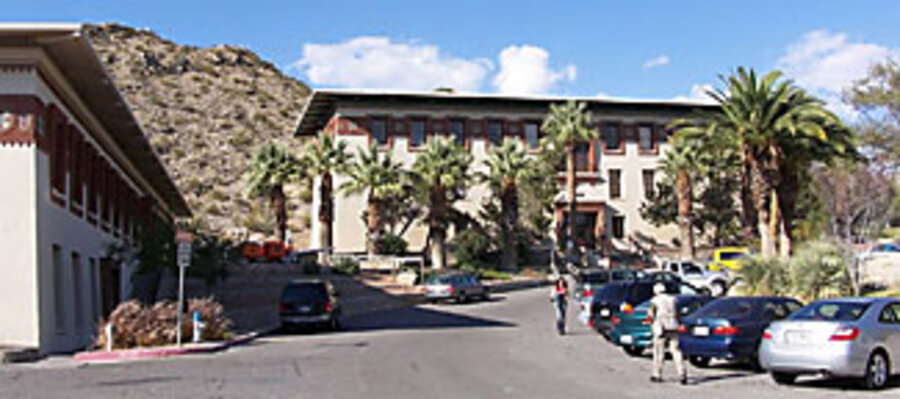Surprising echoes of Bhutan in Texas
Loading...
| El Paso, Texas
They're a curiosity on an American campus – the Asian-style buildings with sloping walls, wide red friezes, and overhanging roofs at the University of Texas at El Paso (UTEP). They seem almost to lean against the Franklin Mountain foothills.
Anyone seeing them for the first time could be forgiven for seeming puzzled: How did they get there? And why?
The central character in the story that provides the answers is Kathleen Worrell, an academic's wife who liked reading and traveling and writing about her travels.
Although she had never been to the Far East, she had visited Mexico and much of North America.
Her husband, Stephen, was the first dean of the Texas State School of Mines and Metallurgy near Fort Bliss.
On Oct. 29, 1916, when the dean was away on a business trip, a fire broke out in the college's administration building.
By the time it was extinguished, virtually nothing was left of the structure. The school's chemistry lab, mineral collections, and records had all been destroyed.
Although two other buildings were left, the heart of the school was gone and, clearly, had to be replaced.
A rebuilding project
Within two months, a 23-acre rocky site nine miles away in El Paso had been donated. But what was the new school to look like?
Mrs. Worrell had an idea. Three years earlier, leafing through the April 1914 issue of National Geographic magazine, she had been entranced by pictures of the little Himalayan mountain kingdom of Bhutan.
The article, called "Castles in the Air" and its accompanying 74 photos, were by an Englishman, John Claude White, who had been assigned by his country as a political officer in the region.
The landscape he had captured on film looked very much like the rocky El Paso foothills that had just been donated for rebuilding the school, and the mountain "fortress-castles" that the Bhutanese called dzongs had thick, sloping walls and projecting roofs that took advantage of their rocky setting. They were set high and fortified as protection from invasion by enemies.
Both because of the cold, windy weather in the area and to guard from invaders, windows in the dzongs were small and located only on the upper portions of the buildings.
Structures so designed, Worrell thought, would work just as well for the new School of Mines campus as in Bhutan.
She and her husband pored over the long National Geographic article together, and he agreed with her. So they took the magazine to a local architectural firm and asked for drawings based on the Bhutanese architecture.
By the summer of 1917, building had begun at the new site. By January of the next year, four Bhutanese-style buildings stood against their mountain background, and the burned-out school had reopened.
Of course, there were differences between the ancient Bhutanese buildings and their American copies.
In Bhutan, the dzongs were painted a dull light gray. In Texas, a dusty brown color seemed to fit perfectly with the surroundings.
The main building (today called Old Main) looked very much like Bhutan's 16th-century Paro-jong Fort. It had a similar broad red band between its upper windows and its hip roof. (In Bhutan, a Laamist Buddhist country, such a band signified a place of worship within.)
Down through the years since then, occasionally new structures at the university have paid only passing attention to the school's Bhutanese architectural beginnings.
Continuing the tradition
But since 1988, when Dr. Diana Natalicio became president of UTEP (of which the School of Mines is part), she has made sure that the heritage has been considered.
For example, a decorative red band was added and an overhanging roof constructed on the 1938 library that had been altered in a non-Bhutanese way in the 1960s. And buildings now under construction have more and more elements of Bhutanese style.
The school and the mountainous kingdom do maintain an arts exchange program, and a number of Bhutanese students have attended UTEP.
Before year's end, there is even going to be a Bhutanese temple at the university, a gift from Bhutan that was presented by Prince Jigyel Ugyen Wangchuck when he visited the school last year.
The 30-foot-tall temple had been erected on the National Mall in Washington for a Smithsonian folklife festival. Afterward, it was taken down and brought to the university to be re-erected.
Relatively little is known about Kathleen Worrell's later years except that she never did have the opportunity to see the real Bhutan. But she and her husband did get a little closer with a move in retirement to Hawaii.






